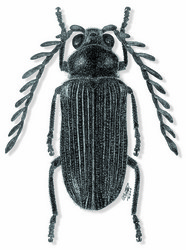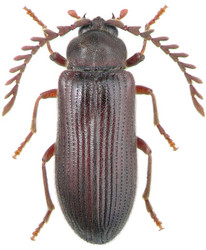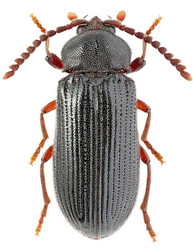Cerophytidae
Rare click beetles
Cleide Costa and Sergio Antonio Vanin


This tree diagram shows the relationships between several groups of organisms.
The root of the current tree connects the organisms featured in this tree to their containing group and the rest of the Tree of Life. The basal branching point in the tree represents the ancestor of the other groups in the tree. This ancestor diversified over time into several descendent subgroups, which are represented as internal nodes and terminal taxa to the right.

You can click on the root to travel down the Tree of Life all the way to the root of all Life, and you can click on the names of descendent subgroups to travel up the Tree of Life all the way to individual species.
For more information on ToL tree formatting, please see Interpreting the Tree or Classification. To learn more about phylogenetic trees, please visit our Phylogenetic Biology pages.
close boxIntroduction
The family includes three genera and 21 described species, distributed as follows (Costa et al. 2003, 2010): the Holarctic Cerophytum Latreille (western and eastern USA; southern and central Europe and Japan); the Neotropical Brachycerophytum Costa et al. (Mexico, Colombia, Peru and Bolivia) and Phytocerum Costa et al. (Mexico, Costa Rica, Nicaragua, Guatemala, French Guiana, Trinidad, Brazil, Bolivia, Paraguay and Argentina). An undescribed species, up to now represented only by females, is known from Africa.
Adult cerophytids have been collected at light traps or Malaise traps, by beating vegetation, in association with rotten wood or bark, and in leaf litter and underground debris (Steiner, 2000; Costa et al. 2003). Adults are capable of “clicking” by the sudden release of the prothorax in the same manner as Elateridae. It is also possible that the enlarged and modified profemora and the lack of metacoxal plates in Cerophytidae are both connected in some way with escape behavior (Costa et al. 2003).
The larva of Cerophytum is highly unusual and differs from those of all other Elateroidea in having unique mouthparts involving paired sucking grooves, styliform mandibles and maxillae, paired thoracic and abdominal glands and bifurcate pretarsi. The larva of C. elateroides was first described by Rey (1887) based on specimens collected with an adult in the rotten trunk of Sambucus (Caprifoliaceae). Mamaev (1978) redescribed and illustrated the Cerophytum larva based on a series of specimens found in the dark fungus–infested wood (brown rot) of a dead standing Ulmus in association with larvae of Oedemeridae (Costa et al. 2003).
Characteristics
(based on Mamaev 1978; Lawrence 1991; Lawrence et al. 1999a, b; Costa et al. 2003)
Adults
- Length 4.3–9.2 mm. Body slightly flattened above, strongly convex below.
- Head deeply inserted into prothorax, slightly declined. Occipital region with weak transverse carina forming short subgenal ridges.
- Frons produced in front of eyes forming median prominence bearing antennal insertions, frontoclypeal region is more or less vertical and mouthparts are ventrally oriented.
- Eyes large, strongly protruding with exocone ommatidia.
- Antennae 11–segmented, serrate to pectinate from antennomeres 3 to 10.
- Labrum free, strongly transverse and truncate.
- Mandibles narrow, strongly curved, unidentate and acute; without mola but with membranous prostheca.
- Maxillae with both galea and lacinia densely setose at apex; apical palpomere more or less expanded and truncate, usually securiform or elongate oval. Ligula membranous, rounded apically; palps approximate, apical palpomere subtriangular.
- Prothorax with posterior angles produced laterally; interlocking device weakly developed.
- Prosternum anterior edge truncate or with ventrally directed chin piece; head rest strongly oblique from lateral perspective
- Prosternal process laterally expanded at middle to form secondary condyle on each side, acute apex fitting into mesoventral cavity.
- Elytra with 9 distinct rows of deep window punctures, sometimes with an additional subhumeral row.
- Legs with metatrochanters more than half as long as metafemora.
- Tarsi 5–5–5; tarsomeres 1 and 5 about equal in length, 2 shorter than 1, 3 and 4 subequals, the latter with a ventral lobe. Pretarsal claws pectinate; empodium not visible.
- Mesoventrite with large, deep mesal cavity, preceded by sclerotized lip, flanked anteriorly by a pair of concave areas and posteriorly by mesocoxal cavities, and extending posteriorly almost to edge of ventrite.
- Hind wing with apical field bearing 2 parallel, oblique, anterior sclerotizations; radial cell elongate; cross–vein r3 extending to RP; medial field with 4 free veins.
- Abdomen with basal four ventrites connate; base of tergite IX and sternite X fused.
- Aedeagus of trilobate type, symmetrical; phallobase Y–shaped; parameres projecting anteriorly, beneath phallobase; parameres divided into proximal sclerotized and distal membranous regions.
- Ovipositor long and narrow; coxites not divided, styli short and terminal, baculi elongate.
Larvae
- Body elongate, robust but more or less parallel–sided, slightly curved ventrally; vestiture consisting of fine setae only.
- Head prognathous and protracted much narrower than thorax; frontal arms and dorsal endocarinae absent; ventral longitudinal endocarinae present.
- One stemma on each side of head, with well developed lens.
- Antennae short, 3–segmented; subconical sensorium on preapical antennomere, which bears a second conical sensorium.
- Frontoclypeal suture vaguely indicated. Labrum fused to head capsule.
- Sucking mouthparts formed by styliform mandibles and maxillae enclosed in separate lateral channels; mandibles flattened, symmetrical and non–opposable, internal channel extending from near base to apex; galea and lacinia forming slender, blade–like, channelled mala.
- Ventral mouthparts strongly retracted forming maxillolabial complex; labium forming a five–toothed plate
- Prementum and hypopharynx forming 5–dentate sclerome; postmentum subquadrate; labial palps 2–segmented with subacute apical palpomere.
- Paired gland openings present on all thoracic terga and abdominal terga I–VIII.
- Thoracic and abdominal spiracles biforous; closing apparatus present
- Anterior pretarsus bifurcate, with 2 setae.
- Abdominal segments I–VIII each with 3 clearly defined lateral lobes on each side; terga densely clothed with long hairs.
- Abdominal segment IX without urogomphi.
Taxonomy
Latreille (1825) placed Cerophytum in the group Sternoxi of Serricornia, along with Buprestidae and most elateroid genera known at the time. In 1834, he proposed a family group based on Cerophytum, and this was recognized by Lacordaire (1857) who suggested a relationship with Eucnemidae. Crowson (1955) considered the family to be part of the Elateroidea (sensu stricto), and this has been followed by most workers. The unusual, apparently plesiomorphic nature of the cerophytid propleurocoxal mechanism prompted Hlavac (1975) to remove the group from Elateroidea and to place it together with two other elateriform families of doubtful affinities, Artematopodidae and Brachypsectridae. In cladograms produced by Lawrence (1988) Cerophytidae formed a clade with Eucnemidae and Throscidae (sensu stricto) or was basal to a clade containing these two families plus Elateridae. A similar association was found in analyses conducted by Calder et al. (1993), Beutel (1995), and Lawrence et al. (1995). In Muona’s (1993) revision of Eucnemidae, Cerophytidae were considered basal to the elateroid complex (Elateroidea sensu Crowson 1955) and in a later cladistic analysis (Muona1995) Cerophytidae and Eucnemidae formed one clade whereas Throscidae (sensu Crowson 1955) represented a derived group within Elateridae (Costa et al.2003, 2010).
Classification
(Based on Costa et al., 2003)
- Coleoptera, Polyphaga, Elateriformia, Elateroidea
- Cerophytidae Latreille 1834
- Cerophytum Latreille, 1806 (type species: Elater elateroides Latreille, 1804)
- Brachycerophytum Costa, Vanin, Lawrence & Ide, 2003 (type species: Cerophytum fuscicorne de Bonvouloir, 1870)
- Phytocerum Costa, Vanin, Lawrence & Ide, 2003 (type species: Phytocerum golbachi Costa, Vanin, Lawrence & Ide, 2003)
Discussion of Phylogenetic Relationships
Costa et al. (2003, 2010) carried out a cladistic analysis of the 21 known species of Cerophytidae, with outgroups from Elateridae, Throscidae and Eucnemidae. Three main clades were recognized: (Cerophytum (Brachycerophytum, Phytocerum)). Synapomorphies for the family include: 1. chin piece ventrally directed; 2. posterior pronotal angles produced laterally; 3. metatrochanters more than half as long as metafemora; 4. base of tergite IX and sternite X fused; 5. parameres divided into proximal sclerotized and distal membranous regions; 6. phallobase Y–shaped; 7. parameres projecting anteriorly, beneath phallobase. Possible larval synapomorphies are: sucking mouthparts formed by styliform mandibles and maxillae enclosed in separate lateral channels; anterior pretarsi bifurcate; and labium forming a five–toothed plate. The Holarctic genus Cerophytum is characterized by having the profemur with a longitudinal carina and the dorsal region of the parameres fringed. Synapomorphies for the Neotropical clade include: posterior angles of pronotum reduced; upper distal angle of profemur acute and produced; and lateroposterior margin of phallobase protruding over the bases of parameres. Brachycerophytum is distinguished by the ninth elytral stria strongly convex, basal portion of penis strongly constricted and bursa copulatrix without smooth and elongate sclerites; while Phytocerum autapomorphies include the lack of a chin piece, presence of an additional row of punctures between stria 8 and 9, and sclerotized spermatheca absent.
References
Beutel, R. G. (1995). Phylogenetic analysis of Elateriformia (Coleoptera: Polyphaga) based on larval characters. Journal of Zoological Systematics and Evolutionary Research 33: 145–171.
Calder, A. A., Lawrence, J. F. & Trueman, J. W. (1993). Austrelater, gen. nov. (Coleoptera: Elateridae) with a description of the larva and comments on elaterid relationships. Invertebrate Taxonomy 7: 1349–1394.
Costa, C., Vanin, S. A., Lawrence, J. F. & Ide, S. (2003). Systematics and cladistic analysis of Cerophytidae (Elateroidea: Coleoptera). Systematic Entomology 28: 375–407.
Costa, C., Vanin, S. A., Lawrence, J. F. & Ide, S. 2010. 4.4. Cerophytidae Latreille, 1834. p. 54-61. In Leschen, R. A. B., R. G. Beutel & J. F. Lawrence (eds). Coleoptera, Beetles: Morphology and Systematics (Elateroidea, Bostrichiformia, Cucujiformia partim). Volume 2, 786 p. In: N. P. Kristensen & R. G. Beutel (eds). Handbook of Zoology, Arthropoda: Insecta, Walter de Gruyter GmbH & Co.KG, Berlin.
Crowson, R. A. (1955). The Natural Classification of the Families of Coleoptera. 187 pp. Nathaniel Lloyd, London.
Hlavac, T. F. (1975). The prothorax of Coleoptera (except Bostrichiformia – Cucujiformia). Bulletin of the Museum of Comparative Zoology 147: 137–183.
Lacordaire, J. T. (1857). Histoire naturelle des insectes. Genera des coléoptères ou exposé méthodique et critique de tous le genres proposés jusqu’ici dans cet ordre d’insectes, Vol. 4. 579 pp. Librairie Encyclopédique de Roret, Paris.
Latreille, P. A. (1825). Familles Naturelles du Règne Animal, Exposées Succinctement et dans un Ordre Analytique, avec l’Indication de leurs Genres. 570 pp. J.–B. Baillière, Paris.
Latreille, P. A. (1834). Distribution méthodique de la famille des Serricornes. Annales de la Société Entomologique de France 3: 113–170.
Lawrence, J. F. (1988). Rhinorhipidae, a new beetle family from Australia, with comments on the phylogeny of Elateriformia. Invertebrate Taxonomy 2 (1987): 1–53.
Lawrence, J. F. (1991). Cerophytidae (Elateroidea). Pp. 409–410 in Stehr, F. W. (ed.), Immature Insects, Vol. 2. Kendall / Hunt Publishing Co., Dubuque, Iowa.
Lawrence, J. F. & Newton, A. F., Jr. (1995). Families and subfamilies of Coleoptera (with selected genera, notes and references, and data on family–group names). Pp. 779–1006 in Pakaluk, J. & Ślipiński, S. A. (eds.) Biology, Phylogeny, and Classification of Coleoptera: Papers Celebrating the 80th Birthday of Roy A. Crowson. Muzeum i Instytut Zoologii PAN, Warsaw.
Lawrence, J. F., Hastings, A. M., Dallwitz, M. J., Paine, T. A. & Zurcher, E. J. (1999a). Beetle Larvae of the World: Descriptions, Illustrations, Identification, and Information Retrieval for Families and Subfamilies. CD–ROM, Version 1.1 for MS–Windows. CSIRO Publishing, Melbourne.
Lawrence, J. F., Hastings, A. M., Dallwitz, M. J., Paine, T. A. & Zurcher, E. J. (1999b). Beetles of the World: A Key and Information System for Families and Subfamilies. CD–ROM, Version 1.0 for MS–Windows. CSIRO Publishing, Melbourne.
Mamaev, B. M. (1978). Morphology of the larvae of Cerophytum elateroides Latr. and the phylogenetic ties of the Cerophytidae (Coleoptera) family. Doklady Akademii Nauk SSSR Zoologii 238: 1007–1008 (in Russian).
Muona, J. (1993). Review of the phylogeny, classification and biology of the family Eucnemidae (Coleoptera). Entomologica Scandinavica, Supplement 44: 1–133.
Muona, J. (1995). The phylogeny of Elateroidea (Coleoptera), or which tree is best today? Cladistics 11: 317–341.
Rey, C. (1887). Essai d’Études sur certaines larves des Coléoptères. Addendum. Larve supposé du Cerophytum elateroides, Latreille. Annales de la Société Linéenne de Lyon (Ser. 2) 33: 253 – 254.
Steiner, W. E., Jr. (2000). Records and habitats of the ‘rare click beetle’, Cerophytum pulsator (Haldeman), in Virginia and Maryland (Coleoptera: Cerophytidae). Banisteria 15: 43–45.
Title Illustrations

| Scientific Name | Phytocerum minutum |
|---|---|
| Comments | Holotype specimen (ink drawing on scraperboard; modified from fig.1 Costa et al, 2003). |
| Specimen Condition | Dead Specimen |
| Identified By | Costa, Vanin, Lawrence and Ide |
| Sex | Male |
| Life Cycle Stage | adult |
| View | dorsal |
| Size | 5.1 mm |
| Type | Holotype |
| Copyright |
© Cleide Costa

|
| Scientific Name | Cerophytum japonicum |
|---|---|
| Specimen Condition | Dead Specimen |
| Identified By | Kirill V. Makarov |
| Sex | Male |
| Life Cycle Stage | adult |
| View | dorsal |
| Copyright | © 2011 Kirill V. Makarov |
| Scientific Name | Cerophytum elateroides |
|---|---|
| Specimen Condition | Dead Specimen |
| Identified By | Kirill V. Makarov |
| Sex | Female |
| View | dorsal |
| Copyright | © Kirill V. Makarov |
About This Page
We thank Kirill V. Makarov (Moscow Pedagogical State University) for permission to use the photographs of Cerophytum elateroides and C. japonicum; Carlos Estevão Simonka for the electronic treatment of figure of Phytocerum minutum; Conselho Nacional de Desenvolvimento Científico e Tecnológico (CNPq) for the Research Grant 302721/2007 – 0 to C. Costa.
Cleide Costa

Museu de Zoologia, Universidade de São Paulo, Brasil

Departamento de Zoologia, Instituto de Biociências, Universidade de São Paulo
Correspondence regarding this page should be directed to Cleide Costa at and Sergio Antonio Vanin at
Page copyright © 2011 Cleide Costa and
 Page: Tree of Life
Cerophytidae. Rare click beetles.
Authored by
Cleide Costa and Sergio Antonio Vanin.
The TEXT of this page is licensed under the
Creative Commons Attribution-NonCommercial License - Version 3.0. Note that images and other media
featured on this page are each governed by their own license, and they may or may not be available
for reuse. Click on an image or a media link to access the media data window, which provides the
relevant licensing information. For the general terms and conditions of ToL material reuse and
redistribution, please see the Tree of Life Copyright
Policies.
Page: Tree of Life
Cerophytidae. Rare click beetles.
Authored by
Cleide Costa and Sergio Antonio Vanin.
The TEXT of this page is licensed under the
Creative Commons Attribution-NonCommercial License - Version 3.0. Note that images and other media
featured on this page are each governed by their own license, and they may or may not be available
for reuse. Click on an image or a media link to access the media data window, which provides the
relevant licensing information. For the general terms and conditions of ToL material reuse and
redistribution, please see the Tree of Life Copyright
Policies.
- First online 02 February 2011
- Content changed 02 February 2011
Citing this page:
Costa, Cleide and Sergio Antonio Vanin. 2011. Cerophytidae. Rare click beetles. Version 02 February 2011. http://tolweb.org/Cerophytidae/9194/2011.02.02 in The Tree of Life Web Project, http://tolweb.org/














 Go to quick links
Go to quick search
Go to navigation for this section of the ToL site
Go to detailed links for the ToL site
Go to quick links
Go to quick search
Go to navigation for this section of the ToL site
Go to detailed links for the ToL site